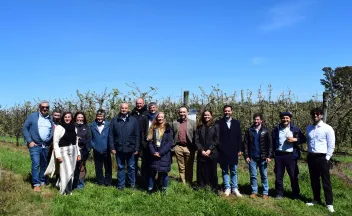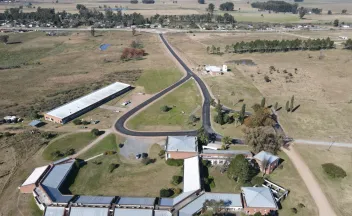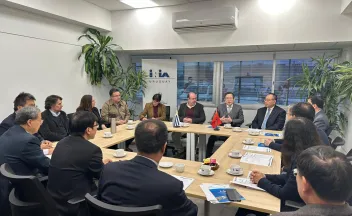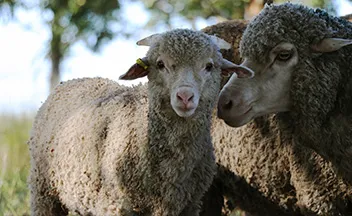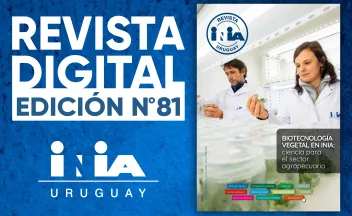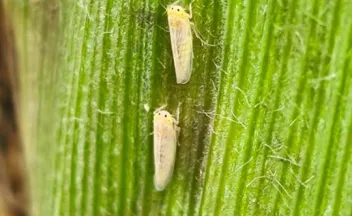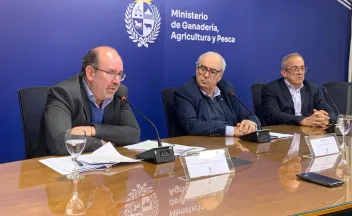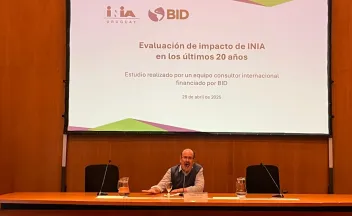Nuestro objetivo en el área de Mejoramiento genético y biotecnología vegetal es coordinar los equipos de mejoramiento genético y biotecnología de INIA para incrementar la eficiencia de los programas y aumentar la ganancia genética, mediante incorporación de nuevas herramientas que requieren una visión integral de todas las especies. Así mismo, participa en la definición de la estrategia institucional para contribuir al desarrollo de genética vegetal a nivel nacional, alineada a las necesidades del sector agroalimentario y a los mercados demandantes.
-
 Terra Incógnita:conociendo el genoma del guayabo del país. [Presentación oral]. Autores: PRITSCH, C. , OBERTI, H. , VAIO, M. , BAZ, N. , MANGINO, M. , BERNÁ, L. , ROSSI, F. , RODRÍGUEZ DECUADRO, S. , QUEZADA, M. , GAIERO, P. , PESCE, M. , FILIPPI, C. , GARAYCOCHEA, S. , DINI, M. , GUTIÉRREZ GONZÁLEZ, J. , VARANI, A.Trabajos presentados en congresos/eventosN°: 804 - 2024
Terra Incógnita:conociendo el genoma del guayabo del país. [Presentación oral]. Autores: PRITSCH, C. , OBERTI, H. , VAIO, M. , BAZ, N. , MANGINO, M. , BERNÁ, L. , ROSSI, F. , RODRÍGUEZ DECUADRO, S. , QUEZADA, M. , GAIERO, P. , PESCE, M. , FILIPPI, C. , GARAYCOCHEA, S. , DINI, M. , GUTIÉRREZ GONZÁLEZ, J. , VARANI, A.Trabajos presentados en congresos/eventosN°: 804 - 2024Fuente: In:Dini, M.; Speroni, G. (Eds.). Encuentro Nacional sobre Frutos Nativos, 11°. Universidad Tecnológica (UTEC), Durazno, Uruguay, 4 y 5 abril 2024, Libro de resúmenes. Canelones (UY):INIA, 2024. p.9-10
-
 Monitoreo de terneros holando portadores de blad mediante curvas de disociación de alta resolución y secuenciación. Autores: BRANDA, A. , FEDERICI, M. , GIANNITTI, F. , CAFFARENA, D. , SCHILD, C. , CASAUX, L. , BRIANO, C. , DALLA RIZZA, M. , LLAMBÍ, S. , FRAGA, M. , RIET-CORREA, F. , DUTRA, F.Otras PublicacionesN°: 780 - 2017
Monitoreo de terneros holando portadores de blad mediante curvas de disociación de alta resolución y secuenciación. Autores: BRANDA, A. , FEDERICI, M. , GIANNITTI, F. , CAFFARENA, D. , SCHILD, C. , CASAUX, L. , BRIANO, C. , DALLA RIZZA, M. , LLAMBÍ, S. , FRAGA, M. , RIET-CORREA, F. , DUTRA, F.Otras PublicacionesN°: 780 - 2017 -
 Herramientas bioestadísticas para mejoramiento de la resistencia genética a enfermedades del tallo en arroz. Autores: ROSAS, J.E. , MARTÍNEZ, S. , BONNECARRERE, V. , BLANCO, P.H. , PÉREZ DE VIDA, F. , GERMAN, S. , JANNINK, J.L. , GUTIÉRREZ, L.Otras PublicacionesN°: 780 - 2017
Herramientas bioestadísticas para mejoramiento de la resistencia genética a enfermedades del tallo en arroz. Autores: ROSAS, J.E. , MARTÍNEZ, S. , BONNECARRERE, V. , BLANCO, P.H. , PÉREZ DE VIDA, F. , GERMAN, S. , JANNINK, J.L. , GUTIÉRREZ, L.Otras PublicacionesN°: 780 - 2017Fuente: In:INIA (Instituto Nacional de Investigación Agropecuaria); INIA Las Brujas; Biotecnología. Jornada de Agrobiotecnología, X. Encuentro Nacional de REDBIO, II. Jornada técnica. Las Brujas, Canelones (UY):INIA, 2017.
-
-
 Aproximaciones genómicas, fisiológicas y de mejoramiento para incrementar la tolerancia a sequía en soja. Autores: BERGER, A. , BONNECARRERE, V. , BORSANI, O. , CASARETTO, E. , CASTILLO, A. , CASTRO, A. , CERETTA, S. , FLEITAS, L. , GALLINO, J.P. , GARAYCOCHEA, S. , IRIARTE, W. , KAVANOVÁ, M. , QUERO, G. , REY, E. , RUIBAL, C. , SIMONDI, S. , VIDAL, S.Otras PublicacionesN°: 780 - 2017
Aproximaciones genómicas, fisiológicas y de mejoramiento para incrementar la tolerancia a sequía en soja. Autores: BERGER, A. , BONNECARRERE, V. , BORSANI, O. , CASARETTO, E. , CASTILLO, A. , CASTRO, A. , CERETTA, S. , FLEITAS, L. , GALLINO, J.P. , GARAYCOCHEA, S. , IRIARTE, W. , KAVANOVÁ, M. , QUERO, G. , REY, E. , RUIBAL, C. , SIMONDI, S. , VIDAL, S.Otras PublicacionesN°: 780 - 2017 -
-
 Prospección y caracterización de bacillus.spp movilizadores de fósforo del suelo, para el desarrollo de inoculantes microbianos. Autores: MARTÍN, N. , BEYHAUT, E. , ALTIER, N. , ABREO, E.Otras PublicacionesN°: 780 - 2017
Prospección y caracterización de bacillus.spp movilizadores de fósforo del suelo, para el desarrollo de inoculantes microbianos. Autores: MARTÍN, N. , BEYHAUT, E. , ALTIER, N. , ABREO, E.Otras PublicacionesN°: 780 - 2017Fuente: In:INIA (Instituto Nacional de Investigación Agropecuaria); INIA Las Brujas; Biotecnología. Jornada de Agrobiotecnología, X. Encuentro Nacional de REDBIO, II. Jornada técnica. Las Brujas, Canelones (UY):INIA, 2017.
-
 Resistencia a marchitez bacteriana en papa mediada por expression de EFR e introgression de genes de resistencia de Solanum commersonii. Autores: BOSCHI, F. , SCHVARTZMAN, C. , MURCHIO, S. , FERREIRA, V. , SIRI, M.I. , GALVÁN, G. , SMOKER, M. , STRANSFEL, L. , ZIPFEL, C. , VILARÓ, F. , DALLA RIZZA, M.Otras PublicacionesN°: 780 - 2017
Resistencia a marchitez bacteriana en papa mediada por expression de EFR e introgression de genes de resistencia de Solanum commersonii. Autores: BOSCHI, F. , SCHVARTZMAN, C. , MURCHIO, S. , FERREIRA, V. , SIRI, M.I. , GALVÁN, G. , SMOKER, M. , STRANSFEL, L. , ZIPFEL, C. , VILARÓ, F. , DALLA RIZZA, M.Otras PublicacionesN°: 780 - 2017Fuente: In:INIA (Instituto Nacional de Investigación Agropecuaria); INIA Las Brujas; Biotecnología. Jornada de Agrobiotecnología, X. Encuentro Nacional de REDBIO, II. Jornada técnica. Las Brujas, Canelones (UY):INIA, 2017.
-
 Identificación molecular de un clon de frutilla mediante marcadores microsatélites. Autores: GIAMBIASI, M. , VICENTE, E. , ARRUABARRENA, A.Otras PublicacionesN°: 780 - 2017
Identificación molecular de un clon de frutilla mediante marcadores microsatélites. Autores: GIAMBIASI, M. , VICENTE, E. , ARRUABARRENA, A.Otras PublicacionesN°: 780 - 2017 -
 Jornada de Agrobiotecnología, X. Encuentro Nacional de REDBIO, II. Autores: INIA (INSTITUTO NACIONAL DE INVESTIGACIÓN AGROPECUARIA) , INIA LAS BRUJAS , BIOTECNOLOGÍAOtras PublicacionesN°: 780 - 2017
Jornada de Agrobiotecnología, X. Encuentro Nacional de REDBIO, II. Autores: INIA (INSTITUTO NACIONAL DE INVESTIGACIÓN AGROPECUARIA) , INIA LAS BRUJAS , BIOTECNOLOGÍAOtras PublicacionesN°: 780 - 2017Fuente: Las Brujas, Canelones (UY):INIA, 2017.
-
 Buscando nuevas herramientas para controlar un viejo enemigo:empleo del receptor EFR en tomate para el control de Clavibacter Michiganensis subsp. Michiganensis. Autores: DALLA RIZZA, M. , MURCHIO, S. , WALASEK, W. , BOSCHI, F. , MAIDANA, M. , SCHVARTZMAN, C. , GIMENEZ, G. , MAESO, D.Otras PublicacionesN°: 756 - 2015
Buscando nuevas herramientas para controlar un viejo enemigo:empleo del receptor EFR en tomate para el control de Clavibacter Michiganensis subsp. Michiganensis. Autores: DALLA RIZZA, M. , MURCHIO, S. , WALASEK, W. , BOSCHI, F. , MAIDANA, M. , SCHVARTZMAN, C. , GIMENEZ, G. , MAESO, D.Otras PublicacionesN°: 756 - 2015Fuente: In:INIA (Instituto Nacional de Investigación Agropecuaria); Programa Nacional Producción Hortícola. Resultados experimentales en sanidad de tomate y morrón. Jornada de Divulgación. Canelones (Uruguay):INIA, 2015.
-
 Buscando nuevas herramientas para controlar un viejo enemigo: empleo del receptor EFR en tomate para el control de Clavibacter Michiganensis subsp. Michiganensis. Autores: DALLA RIZZA, M. , MURCHIO, S. , WALASEK, W. , BOSCHI, F. , MAIDANA, M. , SCHVARTZMAN, C. , GIMENEZ, G. , MAESO, D.Otras PublicacionesN°: 756 - 2015
Buscando nuevas herramientas para controlar un viejo enemigo: empleo del receptor EFR en tomate para el control de Clavibacter Michiganensis subsp. Michiganensis. Autores: DALLA RIZZA, M. , MURCHIO, S. , WALASEK, W. , BOSCHI, F. , MAIDANA, M. , SCHVARTZMAN, C. , GIMENEZ, G. , MAESO, D.Otras PublicacionesN°: 756 - 2015



